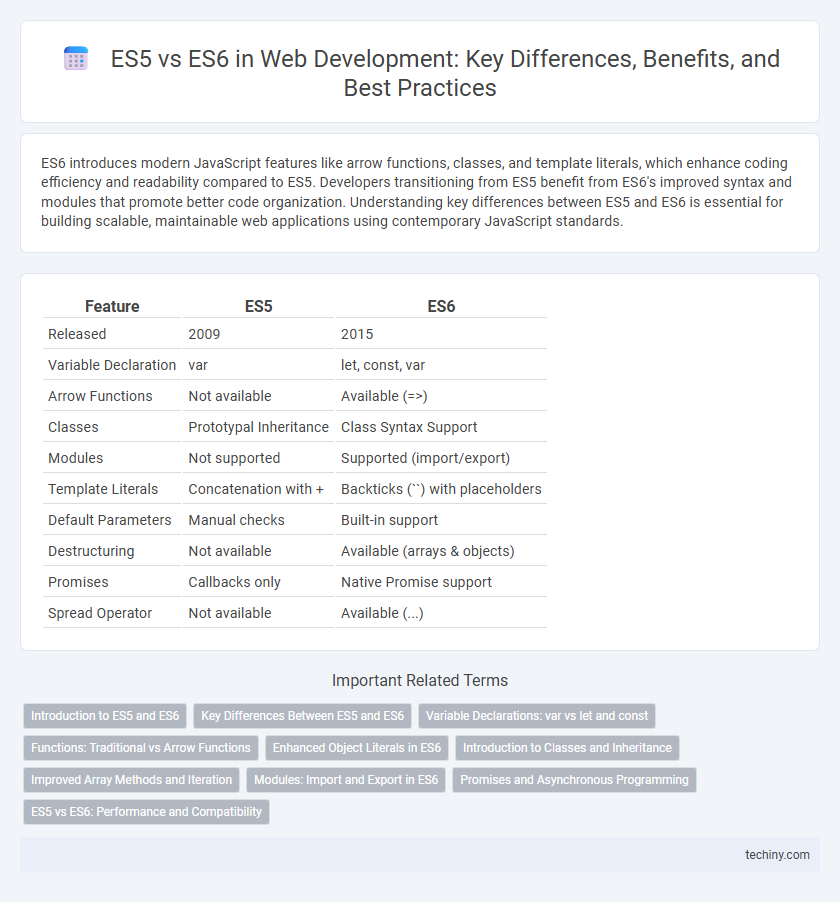ES6 introduces modern JavaScript features like arrow functions, classes, and template literals, which enhance coding efficiency and readability compared to ES5. Developers transitioning from ES5 benefit from ES6's improved syntax and modules that promote better code organization. Understanding key differences between ES5 and ES6 is essential for building scalable, maintainable web applications using contemporary JavaScript standards.
Table of Comparison
| Feature | ES5 | ES6 |
|---|---|---|
| Released | 2009 | 2015 |
| Variable Declaration | var | let, const, var |
| Arrow Functions | Not available | Available (=>) |
| Classes | Prototypal Inheritance | Class Syntax Support |
| Modules | Not supported | Supported (import/export) |
| Template Literals | Concatenation with + | Backticks (``) with placeholders |
| Default Parameters | Manual checks | Built-in support |
| Destructuring | Not available | Available (arrays & objects) |
| Promises | Callbacks only | Native Promise support |
| Spread Operator | Not available | Available (...) |
Introduction to ES5 and ES6
ES5 (ECMAScript 5), released in 2009, introduced critical features like strict mode, JSON support, and improved array methods, which enhanced JavaScript's usability and performance in web development. ES6 (ECMAScript 2015) brought significant advancements including arrow functions, classes, modules, template literals, and promises, revolutionizing modern JavaScript coding practices. Understanding the evolution from ES5 to ES6 is essential for leveraging advanced syntax and improving code maintainability in contemporary web applications.
Key Differences Between ES5 and ES6
ES6 introduced significant improvements over ES5, including let and const for block-scoped variable declarations, arrow functions for concise syntax, and template literals for easier string interpolation. ES6 also brought enhanced object literals, classes for object-oriented programming, and modules for better code organization, which are absent in ES5. These features improve code readability, maintainability, and performance in modern JavaScript development.
Variable Declarations: var vs let and const
In ES5, variable declarations rely on `var`, which is function-scoped and prone to hoisting issues that can lead to bugs. ES6 introduces `let` and `const`, offering block-scoped variables that enhance code clarity and prevent accidental reassignments, with `const` specifically enforcing immutability for constant values. Choosing `let` or `const` over `var` improves memory management and reduces errors in modern JavaScript development.
Functions: Traditional vs Arrow Functions
ES5 relies on traditional function expressions that create their own `this` context, often leading to confusion in nested callbacks. ES6 introduces arrow functions that inherit the `this` value from the enclosing scope, simplifying the handling of context in asynchronous code. Arrow functions also offer more concise syntax, eliminating the need for the `function` keyword and enabling cleaner, more readable code in modern JavaScript development.
Enhanced Object Literals in ES6
ES6 introduces enhanced object literals, providing a more concise and expressive syntax compared to ES5 by allowing shorthand property names, computed property keys, and method definitions without the function keyword. This improvement simplifies object creation, making code cleaner and easier to maintain while improving readability and reducing boilerplate. Developers benefit from these features by writing less verbose and more declarative JavaScript, which enhances productivity and aligns with modern web development practices.
Introduction to Classes and Inheritance
ES6 introduced classes and inheritance to JavaScript, providing a clearer and more concise syntax compared to ES5's prototype-based approach. In ES6, the `class` keyword simplifies the creation of constructor functions and inheritance hierarchies, enabling developers to define methods and extend parent classes using the `extends` keyword. This modern structure enhances code readability and maintainability, replacing the verbose and complex prototype chaining found in ES5.
Improved Array Methods and Iteration
ES6 introduces enhanced array methods like forEach, map, filter, and reduce with improved performance and readability compared to ES5. Iteration in ES6 benefits from the for...of loop, which simplifies traversing iterable objects, unlike the traditional for loop or for...in used in ES5. These improvements boost code clarity and enable more efficient data manipulation in modern web development.
Modules: Import and Export in ES6
ES6 introduced native module support with import and export statements, enabling better code organization and reuse compared to ES5's lack of formal module syntax. ES6 modules allow developers to export variables, functions, or classes and import them selectively, improving maintainability and dependency management in modern web applications. This module system is statically analyzable, enhancing optimization opportunities like tree shaking in bundlers such as Webpack and Rollup.
Promises and Asynchronous Programming
ES6 introduced Promises, revolutionizing asynchronous programming by providing a cleaner, more manageable alternative to ES5's callback functions, which often led to callback hell. Promises in ES6 enable better handling of asynchronous operations through methods like .then(), .catch(), and Promise.all(), enhancing code readability and error management. This shift significantly improves the development of non-blocking web applications, making asynchronous code more predictable and easier to maintain compared to the ES5 approach.
ES5 vs ES6: Performance and Compatibility
ES6 introduces features like arrow functions, let/const, and template literals that improve code readability and development efficiency but may have varied performance impacts across different browsers compared to ES5. While ES5 boasts broader compatibility with legacy browsers, ES6 modules and advanced syntax require transpilation tools like Babel to ensure cross-browser support. Optimizing web applications involves balancing ES6's modern capabilities with ES5's proven compatibility and performance stability.
ES5 vs ES6 Infographic

 techiny.com
techiny.com